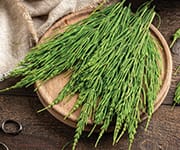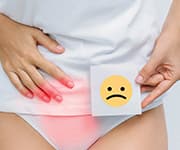Life Extension Magazine®
For many women, frequent trips to the bathroom or needing to get up at night to urinate are a drain on quality of life.1,2
Even a good laugh can lead to urinary incontinence.
In an eight-week clinical trial, a blend of three plant extracts improved urination issues in women as follows:3
- Incontinence episodes were reduced by 65%,
- Urinary urgency episodes decreased by 57%,
- Nighttime urination episodes were reduced by 43%, and
- Daytime urination frequency returned to normal.
A robust 79% of women who took the blend reported a significant benefit, compared to 17% who took a placebo.
Bladder Problems Worsen with Age
Urinary issues tend to become more common in women as they age. Onset of symptoms is usually observed over the age of 40.4
The prevalence and severity of symptoms are greater in women than in men. A population study with 40- to 99-year-old women participants from the U.S., UK, and Sweden revealed that:5
- 56% experience incontinence,
- 36% experience urinary urgency,
- 34% experience nighttime urination, and
- 25% experience frequent urination.
The median daytime urinary frequency is 3-4 hours (6-8 times daily).6 Those afflicted with an overactive bladder have to go to the bathroom more frequently (>8 times during the day and >1 time at night).2
According to a study, only 46% of symptomatic women have discussed any urinary concerns with their health care provider.4 Many are self-conscious about these symptoms but assume they are an unavoidable part of aging.7
Those who do seek medical advice are often prescribed drugs with minimal benefits at best. For example, only about 13% of participants taking drugs achieve urinary continence, and side effects prompt some patients to discontinue medication.3
In contrast, a clinical study found that a blend of three plant extracts3 was well-tolerated by participating women, improved urinary symptoms, and significantly improved participants’ quality of life.
How Does this Herbal Combination Work?
In a rat model of overactive bladder, the herbal blend reversed the alterations in various biomarkers in the urine and lining of bladder and muscle, leading to improvement of urinary symptoms in:7
- Storage phase (e.g., urgency, frequency, nocturia)
- Voiding/post-voiding phase (e.g., hesitancy, intermittency, weak stream, dribbling post-voiding)
The researchers suggest that the ability of these plant extracts to favorably alter markers of urinary changes in the rat model may explain the clinically significant benefits observed in the human study.7
Twenty Years in Development
More than 20 years ago, naturopath and medical herbalist Dr. Tracey Seipel began researching an effective solution to urinary problems for her patients.8 She sifted through the medical literature on plant compounds that had been traditionally used to treat bladder issues and gradually began incorporating some into her clinical practice.3
Eventually, Dr. Seipel’s experiential research allowed her to refine a treatment that included a blend of three plant extracts, each with a history of effectiveness and each from a different area of health care:
- Horsetail (Equisetum arvense) from Western herbal medicine,
- Lindera (Lindera aggregata) from Chinese medicine, and
- Three-leaf caper (Crateva nurvala) from Ayurvedic medicine.
Reduced Urinary Symptoms
To validate Dr. Seipel’s research on the blend of three plant extracts, scientists designed a randomized, placebo-controlled trial.3
They enlisted 88 women with an average age of 62 years who had at least two of the following symptoms:
- Daytime urination episodes of 10 or more a day,
- Incontinence episodes of one or more per day,
- Urinary urgency episodes of two or more a day, and
- Nighttime urination episodes of two or more a night.
The treatment group took 840 mg of the extract blend in the form of two capsules once daily. After just eight weeks:3
- Daytime urination episodes were restored to normal levels, decreasing from an average of 11.59 times a day to an average of just 7.88 times a day.
- Incontinence episodes were reduced by 65%, from an average of 3.49 times a day to an average of only 1.21 times a day,
- Urinary urgency episodes decreased by 57%, from an average of 3.77 times a day to an average of just 1.61 times a day, and
- Nighttime urination episodes were reduced by 43%, from an average of 3.76 times a night to an average of 2.15 times a night.
Improved Quality of Life
Women taking the plant extract also reported impressive improvements in quality-of-life questionnaires, including a:3
- 50% decrease in overactive bladder,
- 39% decrease in incontinence, and
- 39% decrease in urogenital distress.
- A remarkable 79% of women who took the blend reported feeling a significant benefit, compared to 17% of women in the placebo group.
The extract blend produced these results without the side effects commonly seen with medications.3
What you need to know
Help For Women’s Bladder Problems
- Urinary symptoms are common in women, especially after age 40. These include frequent urination, urinary incontinence, urinary urgency, and nighttime urination.
- A formula has been developed from extracts of three plants with a history of traditional use in addressing bladder disorders: horsetail, lindera, and three-leaf caper.
- In an animal model of overactive bladder, the herbal combination treatment reversed the detrimental shifts in bladder function parameters and in the levels of several tested biomarkers in the bladder epithelium and muscle.
- A placebo-controlled clinical trial has validated that this three-extract blend significantly improves urinary symptoms in women without harsh side effects
- After eight weeks, this combination reduced daytime urination frequency to the normal level and incontinence episodes by 65%. It also significantly reduced urinary urgency and nighttime urination and improved quality of life.
Summary
Urinary problems are common in women as they age and can impact the quality of their life.
In a clinical study, a blend of extracts from the plants horsetail, lindera, and three-leaf caper was shown to reduce daytime urinary frequency, urinary incontinence, urinary urgency, and nighttime urination in women.
These benefits translate into improved quality of life, without the adverse side effects of drugs commonly prescribed for these problems.
Lower Urinary Tract Symptoms
- Lower urinary tract symptoms (LUTS) are divided into storage and voiding/micturition (urination) phases.
- Storage phase involves overactive bladder (OAB) and stress incontinence (SI).
- Overactive bladder (OAB) is a group of urinary symptoms, defined as having an urgent need to empty the bladder during the day or night, with or without incontinence.
- Median daytime urinary frequency is 3-4 hours 6-8 times daily.6
- Those afflicted with an overactive bladder have to go to the bathroom frequently (>8 times during the day and >1 time at night), may leak urine into their clothes, and report feeling depressed, stressed, and sleep deprived.
- This could be due to overactivity of the bladder detrusor (a muscle lining the urinary bladder, that manages storage and voiding of urine).2
- Stress incontinence is another common bladder problem in which women leak urine while sneezing, laughing, or doing other physical activities.
- Voiding symptoms include hesitancy, straining, terminal dribbling, intermittency, and slow, weak and/or interrupted stream.2
If you have any questions on the scientific content of this article, please call a Life Extension Specialist at 1-866-864-3027.
References
- Macdiarmid SA. Maximizing the treatment of overactive bladder in the elderly. Rev Urol. 2008 Winter;10(1):6-13.
- Corcos J, Przydacz M, Campeau L, et al. CUA guideline on adult overactive bladder. Can Urol Assoc J. 2017 May;11(5):E142-e73.
- Schoendorfer N, Sharp N, Seipel T, et al. Urox containing concentrated extracts of Crataeva nurvala stem bark, Equisetum arvense stem and Lindera aggregata root, in the treatment of symptoms of overactive bladder and urinary incontinence: a phase 2, randomised, double-blind placebo controlled trial. BMC Complement Altern Med. 2018 Jan 31;18(1):42.
- Benner JS, Becker R, Fanning K, et al. Bother related to bladder control and health care seeking behavior in adults in the United States. J Urol. 2009 Jun;181(6):2591-8.
- Coyne KS, Sexton CC, Thompson CL, et al. The prevalence of lower urinary tract symptoms (LUTS) in the USA, the UK and Sweden: results from the Epidemiology of LUTS (EpiLUTS) study. BJU Int. 2009 Aug;104(3):352-60.
- Lukacz ES, Whitcomb EL, Lawrence JM, et al. Urinary frequency in community-dwelling women: what is normal? Am J Obstet Gynecol. 2009 May;200(5):552.e1-7.
- Zapała Ł, Juszczak K, Adamczyk P, et al. New Kid on the Block: The Efficacy of Phytomedicine Extracts Urox® in Reducing Overactive Bladder Symptoms in Rats. Front Mol Biosci. 2022;9:896624.
- Available at: https://seipelgroup.com/team/. Accessed Febuary, 1, 2023.






